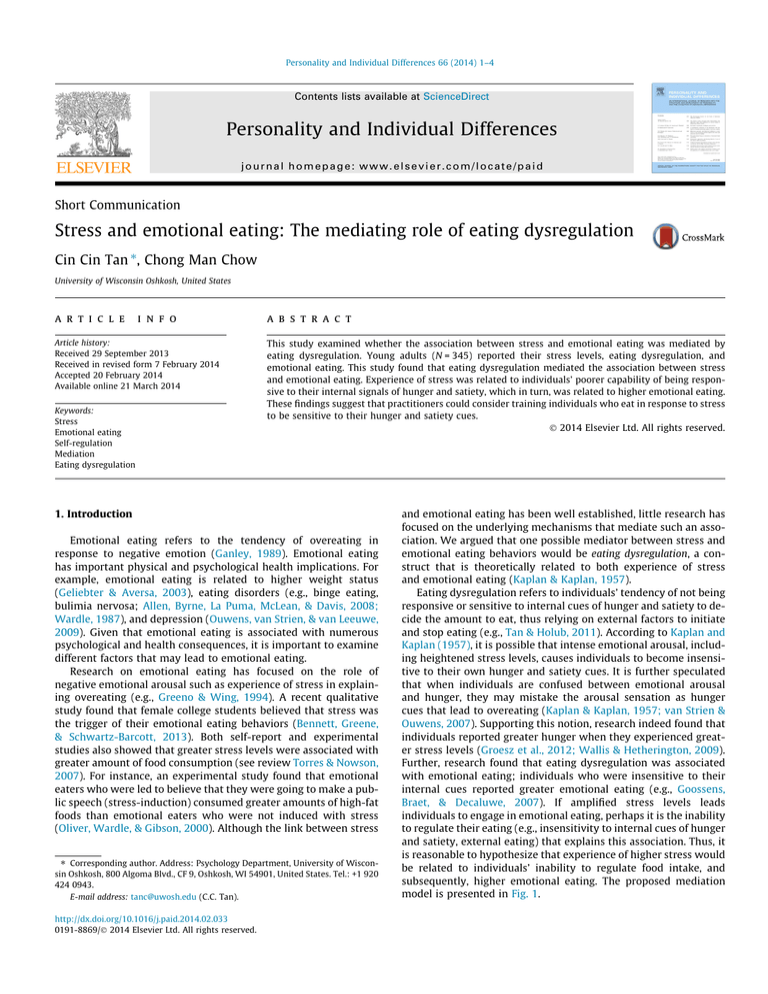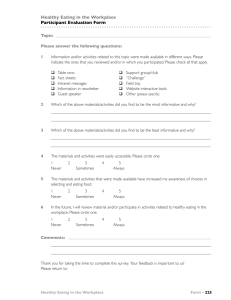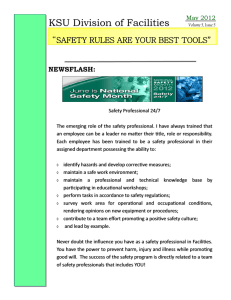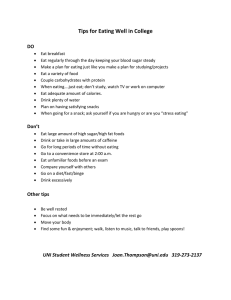Stress Cin , Chong Man Chow Short
advertisement

Personality and Individual Differences 66 (2014) 1–4 Contents lists available at ScienceDirect Personality and Individual Differences journal homepage: www.elsevier.com/locate/paid Short Communication Stress and emotional eating: The mediating role of eating dysregulation Cin Cin Tan ⇑, Chong Man Chow University of Wisconsin Oshkosh, United States a r t i c l e i n f o Article history: Received 29 September 2013 Received in revised form 7 February 2014 Accepted 20 February 2014 Available online 21 March 2014 Keywords: Stress Emotional eating Self-regulation Mediation Eating dysregulation a b s t r a c t This study examined whether the association between stress and emotional eating was mediated by eating dysregulation. Young adults (N = 345) reported their stress levels, eating dysregulation, and emotional eating. This study found that eating dysregulation mediated the association between stress and emotional eating. Experience of stress was related to individuals’ poorer capability of being responsive to their internal signals of hunger and satiety, which in turn, was related to higher emotional eating. These findings suggest that practitioners could consider training individuals who eat in response to stress to be sensitive to their hunger and satiety cues. Ó 2014 Elsevier Ltd. All rights reserved. 1. Introduction Emotional eating refers to the tendency of overeating in response to negative emotion (Ganley, 1989). Emotional eating has important physical and psychological health implications. For example, emotional eating is related to higher weight status (Geliebter & Aversa, 2003), eating disorders (e.g., binge eating, bulimia nervosa; Allen, Byrne, La Puma, McLean, & Davis, 2008; Wardle, 1987), and depression (Ouwens, van Strien, & van Leeuwe, 2009). Given that emotional eating is associated with numerous psychological and health consequences, it is important to examine different factors that may lead to emotional eating. Research on emotional eating has focused on the role of negative emotional arousal such as experience of stress in explaining overeating (e.g., Greeno & Wing, 1994). A recent qualitative study found that female college students believed that stress was the trigger of their emotional eating behaviors (Bennett, Greene, & Schwartz-Barcott, 2013). Both self-report and experimental studies also showed that greater stress levels were associated with greater amount of food consumption (see review Torres & Nowson, 2007). For instance, an experimental study found that emotional eaters who were led to believe that they were going to make a public speech (stress-induction) consumed greater amounts of high-fat foods than emotional eaters who were not induced with stress (Oliver, Wardle, & Gibson, 2000). Although the link between stress ⇑ Corresponding author. Address: Psychology Department, University of Wisconsin Oshkosh, 800 Algoma Blvd., CF 9, Oshkosh, WI 54901, United States. Tel.: +1 920 424 0943. E-mail address: tanc@uwosh.edu (C.C. Tan). http://dx.doi.org/10.1016/j.paid.2014.02.033 0191-8869/Ó 2014 Elsevier Ltd. All rights reserved. and emotional eating has been well established, little research has focused on the underlying mechanisms that mediate such an association. We argued that one possible mediator between stress and emotional eating behaviors would be eating dysregulation, a construct that is theoretically related to both experience of stress and emotional eating (Kaplan & Kaplan, 1957). Eating dysregulation refers to individuals’ tendency of not being responsive or sensitive to internal cues of hunger and satiety to decide the amount to eat, thus relying on external factors to initiate and stop eating (e.g., Tan & Holub, 2011). According to Kaplan and Kaplan (1957), it is possible that intense emotional arousal, including heightened stress levels, causes individuals to become insensitive to their own hunger and satiety cues. It is further speculated that when individuals are confused between emotional arousal and hunger, they may mistake the arousal sensation as hunger cues that lead to overeating (Kaplan & Kaplan, 1957; van Strien & Ouwens, 2007). Supporting this notion, research indeed found that individuals reported greater hunger when they experienced greater stress levels (Groesz et al., 2012; Wallis & Hetherington, 2009). Further, research found that eating dysregulation was associated with emotional eating; individuals who were insensitive to their internal cues reported greater emotional eating (e.g., Goossens, Braet, & Decaluwe, 2007). If amplified stress levels leads individuals to engage in emotional eating, perhaps it is the inability to regulate their eating (e.g., insensitivity to internal cues of hunger and satiety, external eating) that explains this association. Thus, it is reasonable to hypothesize that experience of higher stress would be related to individuals’ inability to regulate food intake, and subsequently, higher emotional eating. The proposed mediation model is presented in Fig. 1. 2 C.C. Tan, C.M. Chow / Personality and Individual Differences 66 (2014) 1–4 Fig. 1. Path model examining the mediating roles of eating dysregulation between experience of stress and emotional eating. Unstandardized coefficients are presented, with standard errors in the parentheses. ⁄⁄p < .01. 2.2.3. Emotional eating Participants completed the 13-item emotional eating subscale of the Dutch Eating Behavior Questionnaire (DEBQ; van Strien, Fritjers, Bergers, & Defares, 1986) to measure emotional eating behaviors. One example item reads ‘‘Do you have a desire to eat when you are emotionally upset?’’. Participants rated the items on a scale ranging from 1 (never) to 5 (very often). All items were averaged to create a composite, with higher scores reflecting greater emotional eating behaviors. The reliability of this measure was satisfactory, with Cronbach’s a = .94. 3. Results 2. Method 3.1. Descriptive statistics and correlational analyses 2.1. Participants and procedure Participants were recruited from a university located in Wisconsin, USA. Participants completed a series of questionnaires and received one credit as part of the course requirements. After obtaining participants’ informed consent, participants completed a series of questionnaires on computers. The final sample was 345 participants (227 females) with a mean age of 19.5 (SD = 1.3). Participants reported their weight in pounds and height in inches which were used to calculate their body mass index (BMI; kg/m2). Participants’ BMI ranged from 16.6 to 47.4 (M = 23.9, SD = 4.3). Most of the participants (67%) were normal weight (BMI score between 18.5 and 24.9), 4% were underweight (BMI score below 18.5), 20% were overweight (BMI score between 25.0 and 29.9), and 9% were obese (BMI score above 30.0). Ethnic composition for the current sample was Caucasians (84%), African Americans (4%), Asians (6%), Hispanics (2%), and Mixed/Other (4%). 2.2. Measures 2.2.1. Stress Participants completed the 14-item Global Measure of Perceived Stress (Cohen, Kamarck, & Mermelstein, 1983) to measure their stress levels. Participants provided ratings on how often they find their lives unpredictable, uncontrollable, and overloaded during the last month. For example, one item reads ‘‘In the last month, how often have you been upset because of something that happened unexpectedly?’’. Another item reads ‘‘In the last month, how often have you felt that you were unable to control the important things in your life?’’. Participants rated the items on a scale ranging from 0 (never) to 4 (very often). All 14 items were averaged to form a composite, with higher scores reflecting higher levels of stress. For the current study, the reliability of this measure was satisfactory, with Cronbach’s a = .83. 2.2.2. Eating dysregulation Participants’ self-regulation abilities in eating was measured using an 8-item scale adapted and modified from a previous study with young children (Tan & Holub, 2011). As an example, the item ‘‘my child knows how much food s/he should eat until full’’ was modified to ‘‘I know how much food I should eat until full’’. Items included: (1) I know how much food I should eat until full, (2) I stop eating when I am full, (3) I know when I should stop eating, (4) If I am full, I will not eat snacks, (5) I eat even when I am not hungry (reversed), (6) If I am full, I will not get more foods, (7) I know when I am full, and (8) I eat even when I am already full (reversed). Participants rated the items on a scale ranging from 1 (disagree) to 5 (agree). All items were averaged to create a composite. For interpretation purposes, the composite score was reversed so that higher scores reflected greater eating dysregulation. The reliability of this measure was satisfactory, with Cronbach’s a = .79. Table 1 presents the means, standard deviations, and correlations among the study variables. Gender differences with independent t-tests revealed that females reported higher stress and engaged in more emotional eating. Males, in contrast, had higher BMI compared to females. Results showed that higher stress levels were associated with higher eating dysregulation and higher emotional eating. Furthermore, higher eating dysregulation was related to higher emotional eating. However, BMI was not significantly associated with other study variables. 3.2. Mediation analysis The proposed mediation hypothesis was examined with a path model (see Fig. 1) implemented with the PROCESS SPSS Macro (Hayes, 2012). Participants’ gender was included as a covariate. Because BMI was found not significantly related to other variables, it was not included in the model. Significance of the mediation effects were examined through indirect effects with bootstrapped (samples = 5000) standard errors and bias corrected 95% confidence intervals. Confirming the hypothesis, results also showed that the indirect effect of stress on emotional eating through emotion dysregulation was significant, bindirect = .15, SE = .04, CI95 = .07–.23, p < .001. Specifically, the model showed that experience of higher stress was related to higher eating dysregulation, which in turn, was related to greater engagement of emotional eating. It is noteworthy that stress was still significantly related to emotional eating when eating dysregulation was considered simultaneously in the model. 3.3. Supplemental analyses In order to examine the possibility that gender may moderate the mediating effect of eating dysregulation between stress and emotional eating, two path models were fitted separately for males and females. The paths were then constrained to be equivalent for males and females. Imposing the constrains did not lead to a significant decrease in model fit, suggesting that gender did not moderate the mediation effect of eating dysregulation between stress and Table 1 Means, standard deviations, and correlations among study variables. 1. Emotional eating 2. Stress 3. Eating dysregulation 4. BMI Males M (SD) Females M (SD) t-values ** p < .01. 1 2 3 4 – .31** .49** .01 1.99 (.75) 2.47 (.74) 5.72** – .23** .02 2.82 (.51) 3.01 (.50) 3.33** – .01 3.87 (.70) 3.74 (.68) 1.65 – 24.95 (4.05) 23.70 (4.27) 2.63** C.C. Tan, C.M. Chow / Personality and Individual Differences 66 (2014) 1–4 emotional eating. Furthermore, we also examined the possibility that eating dysregulation would serve as a moderator between stress and emotional eating. The interaction effect between stress and eating dysregulation on emotional eating was not significant. 4. Discussion Eating dysregulation is an understudied construct in research on eating. The current study was the first study that examined the mediating role of eating dysregulation between stress and emotional eating. It was found that individuals who experienced heightened stress levels also suffered from lower eating regulation ability. Furthermore, higher eating dysregulation was also directly related to higher emotional eating. Confirming the mediation hypothesis, indirect effect revealed that eating dysregulation mediated the association between stress and emotional eating. It is likely that heightened stress levels would be related to individuals’ capability of being sensitive to their internal cues of hunger (Kaplan & Kaplan, 1957; van Strien & Ouwens, 2007). In turn, the inability to differentiate between emotional arousal and hunger cues was related to overeating behaviors. It is important to note that alexithymia, or difficulty in identifying and describing feelings and emotions (Sifneos, 1996), is a closely related construct to eating dysregulation. Research found that individuals who were poor in recognizing their feelings in response to emotional arousal consumed more foods (Larsen, van Strien, Eisinga, & Engels, 2006; Ouwens et al., 2009; van Strien & Ouwens, 2007), especially among obese females with binge eating disorders (Pinaquy, Chabrol, Simon, Louvet, & Barbe, 2003). These findings suggest that individuals with alexithymia overeat because they may have mistaken emotional arousal as hunger cues. Given that alexithymia is associated with emotional eating, it is possible that individuals with higher levels of alexithymia would be more vulnerable to stress and engage in greater amount of overeating compared to individuals with lower levels of alexithymia. Therefore, it is important for future research to include both alexithymia and eating dysregulation when examining the effect of stress on emotional eating. One of the current study’s limitations was that the correlational nature of the current study design did not allow us to draw causality. Indeed, researchers recommended that mediation model be examined by experimental or longitudinal data (MacKinnon, Fairchild, & Fritz, 2007). Nevertheless, previous research found that laboratory stress-induction manipulation showed that exposure to stress was associated with food consumption (Oliver et al., 2000). This finding provided strong theoretical argument for the current study that treated stress levels as the leading indicator of emotional eating. Therefore, we argued that the current findings provided initial evidence to support the theoretical mediation model, even with cross-sectional data. These findings would serve as an important stepping stone for future research that employs an experimental or longitudinal design to better clarify the causal relationships among the variables. Additionally, the current study relied on participants’ reports of their own behaviors but not actual behaviors. For instance, some research suggests that reported eating behaviors do not necessarily reflect actual behaviors (Evers, De Ridder, & Adriaanse, 2009). That said, other studies showed an association between reported eating and actual food consumption (van Strien, 2010). To draw a more complete picture of emotional eating, future research may consider using behavioral observation to measure participants’ actual eating behaviors in response to stress in relation to their eating dysregulation. Another limitation was that unlike perceived stress, individual differences in emotional eating and eating dysregulation were not measured within a specific period of time (e.g., in the past month), but as stable traits. This design has prevented us from learning whether the 3 relationships between stress and eating dysregulation or emotional eating are temporal or enduring. Thus, future studies should modify the eating dysregulation or emotional eating measures to better capture these individual differences within a specific timeframe. Despite these limitations, findings from this study highlighted the importance of examining eating dysregulation, the underlying factor that explains the association between stress and emotional eating. These findings have practical implications. For example, clinicians and practitioners who work with emotional eaters could consider targeting individuals’ eating dysregulation when designing interventions. Given that eating dysregulation explained the association between stress and emotional eating, it is important to design an intervention that teaches participants to focus on their internal cues to guide eating behaviors. Research suggests that children who are taught to focus on their internal cues of hunger and satiety when eating are better in regulating their food intake compared to children who are taught to focus on external cues (Birch, McPhee, Shoba, Steinberg, & Krehbiel, 1987). It is possible that by teaching adults to be aware of internal signals of hunger and to be able to differentiate between arousal and hunger, they may reduce their overeating behaviors in response to stress. In conclusion, this study demonstrated that individuals’ eating dysregulation is an important factor when considering the association between stress and emotional eating. References Allen, K. L., Byrne, S. M., La Puma, M., McLean, N., & Davis, E. A. (2008). The onset and course of binge eating in 8- to 13-year-old healthy weight, overweight, and obese children. Eating Behaviors, 9, 438–446. Bennett, J., Greene, G., & Schwartz-Barcott, D. (2013). Perceptions of emotional eating behavior. A qualitative study of college students. Appetite, 60, 187–192. Birch, L. L., McPhee, L., Shoba, B. C., Steinberg, L., & Krehbiel, R. (1987). Clean up your plate: Effects of child feeding practices on the conditioning of meal size. Learning and Motivation, 18, 301–317. Cohen, S., Kamarck, T., & Mermelstein, R. (1983). A global measure of perceived stress. Journal of Health and Social Behavior, 24, 385–396. Evers, C., De Ridder, D. T. D., & Adriaanse, M. A. (2009). Assessing yourself as an emotional eater: Mission impossible? Health Psychology, 28, 717–725. Ganley, R. M. (1989). Emotion and eating in obesity: A review of the literature. International Journal of Eating Disorders, 8, 343–361. Geliebter, A., & Aversa, A. (2003). Emotional eating in overweight, normal weight, and underweight individuals. Eating Behaviors, 3, 341–347. Goossens, L., Braet, C., & Decaluwe, V. (2007). Loss of control over eating in obese youngsters. Behaviour Research and Therapy, 45, 1–9. Greeno, C. G., & Wing, R. R. (1994). Stress-induced eating. Psychological Bulletin, 15, 444–464. Groesz, L., McCoy, S., Carl, J., Saslow, L., Stewart, J., Adler, N., et al. (2012). What is eating you? Stress and the drive to eat. Appetite, 58, 717–721. Hayes, A. F. (2012). PROCESS: A versatile computational tool for observed variable mediation, moderation, and conditional process modeling [White paper]. Retrieved from <http://www.afhayes.com/ public/process2012.pdf>. Kaplan, H. I., & Kaplan, H. S. (1957). The psychosomatic concept of obesity. The Journal of Nervous and Mental Disease, 125, 181–201. Larsen, J. K., van Strien, T., Eisinga, R., & Engels, R. C. (2006). Gender differences in the association between alexithymia and emotional eating in obese individuals. Journal of Psychosomatic Research, 60, 237–243. MacKinnon, D. P., Fairchild, A. J., & Fritz, M. S. (2007). Mediation analysis. Annual Review of Psychology, 58, 593–614. Oliver, G., Wardle, J., & Gibson, E. L. (2000). Stress and food choice: A laboratory study. Psychosomatic Medicine, 62, 853–865. Ouwens, M., van Strien, T., & van Leeuwe, J. (2009). Possible pathways between depression, emotional and external eating. A structural equation model. Appetite, 53, 245–248. Pinaquy, S., Chabrol, H., Simon, C., Louvet, J., & Barbe, P. (2003). Emotional eating, alexithymia, and binge eating disorder in obese women. Obesity Research, 11, 195–201. Sifneos, P. E. (1996). Alexithymia: Past and present. The American Journal of Psychiatry, 153, 137–142. Tan, C., & Holub, S. C. (2011). Children’s self-regulation in eating: Associations with inhibitory control and parents’ feeding behavior. Journal of Pediatric Psychology, 36, 340–345. Torres, S., & Nowson, C. (2007). Relationship between stress, eating behavior, and obesity. Nutrition, 23, 887–894. van Strien, T. (2010). Predicting distress-induced eating with self-reports: Mission impossible or a piece of cake? Health Psychology, 29, 343. 4 C.C. Tan, C.M. Chow / Personality and Individual Differences 66 (2014) 1–4 van Strien, T., Fritjers, J. E. R., Bergers, G. P. A., & Defares, P. B. (1986). The Dutch Eating Behavior Questionnaire (DEBQ) for assessment of restrained, emotional, and external eating behavior. International Journal of Eating Disorders, 5, 295–315. van Strien, T., & Ouwens, M. A. (2007). Effects of distress, alexithymia, and impulsivity on eating. Eating Behaviors, 8, 251–257. Wallis, D. J., & Hetherington, M. M. (2009). Emotions and eating. Self-reported and experimentally induced changes in food intake under stress. Appetite, 52, 355–362. Wardle, J. (1987). Eating style: A validation study of the Dutch eating behaviour questionnaire in normal subjects and women with eating disorders. Journal of Psychosomatic Research, 31, 161–169.






